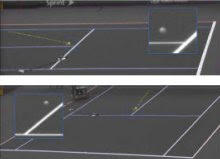The technology behind the challenge system is owned by a UK based company Hawk-Eye Innovations. A series of cameras are placed at strategic locations all around the playing field and they capture the movement of the ball 60 times a second. This information is then used in the following manner:
2D (x,y)
The position of the ball in terms of both the depth and sideways movement on the court is calculated from each frame. Camera movement is compensated for by also tracking the lines of the court.
(c) - Hawk-Eye Innovations
3D (x,y,z)
Strategically placed cameras also capture the height of the ball from the playing surface, which when coupled with the horizontal displacement enables a 3-dimensional view of the Tennis ball's position.(c) - Hawk-Eye Innovations
4D (x,y,z,t)
This process is repeated for each frame so that the 3D positions of the ball can be combined to produce a single trajectory of the flight of the ball. (c) - Hawk-Eye Innovations
Bounce Mark
The trajectory is then used to calculate where the ball will land on the court. According to the rules of the game the call is then made.(c) - Hawk-Eye Innovations.
Hawk-Eye's website claims that during the ITF's evaluation of the system, Hawk-Eye made the right call 100% of the time with an average error of 3.6 mm. These tests were performed in varying wind, light and temperature conditions. So there is a chance for error - however small that chance may be. Hawk-Eye was first used in the 2006 Hopman Cup in Perth, Western Australia, since then all major tournaments except French Open has embraced the use of Hawk-Eye. French Open administrators claim that Hawk-Eye has no place on the Clay Courts as the ball clearly leaves a mark where it lands. Hawk Eye is also very widely used in the game of Cricket, which is where Hawk-Eye was first tested and adopted.






